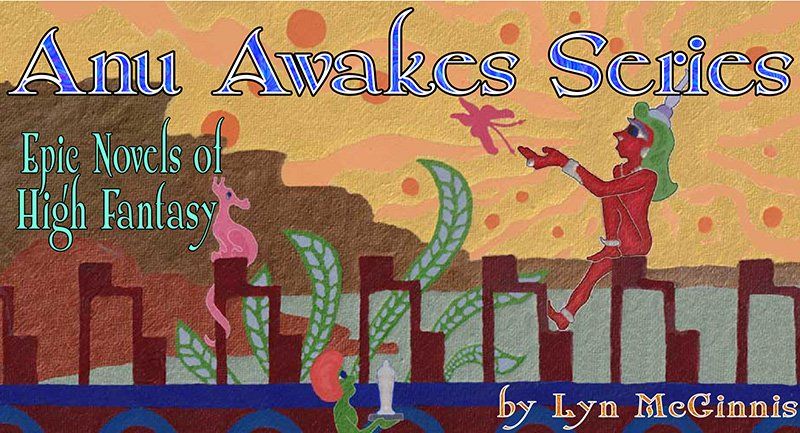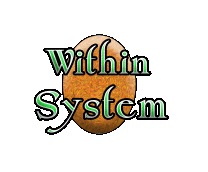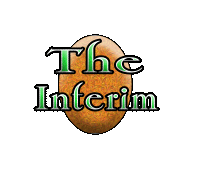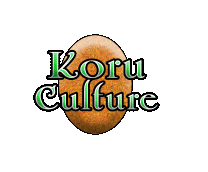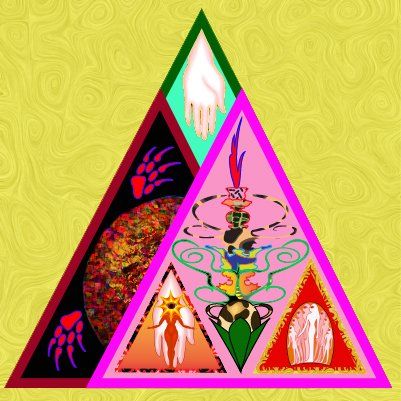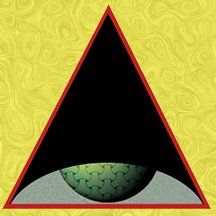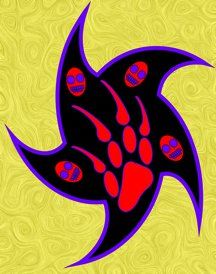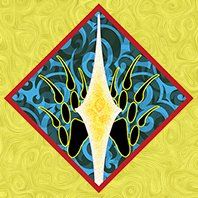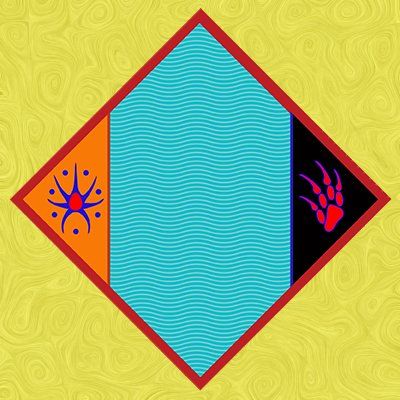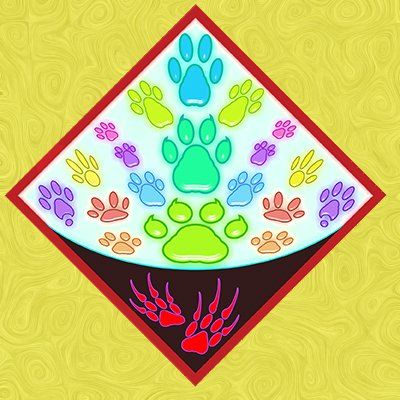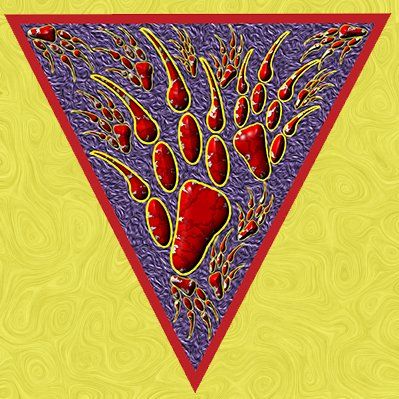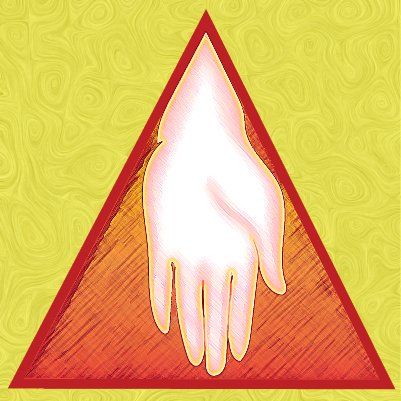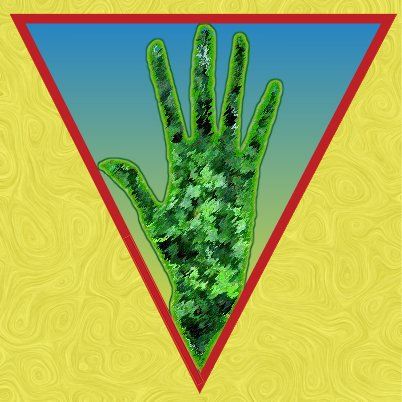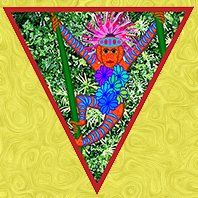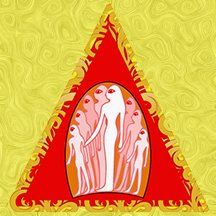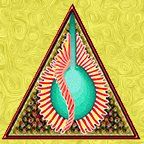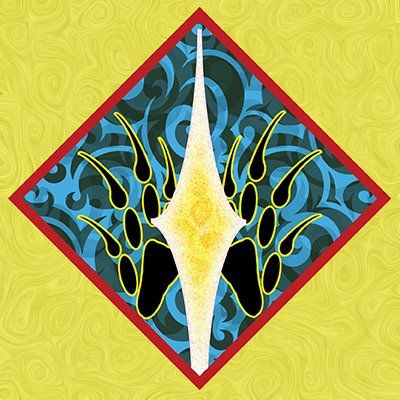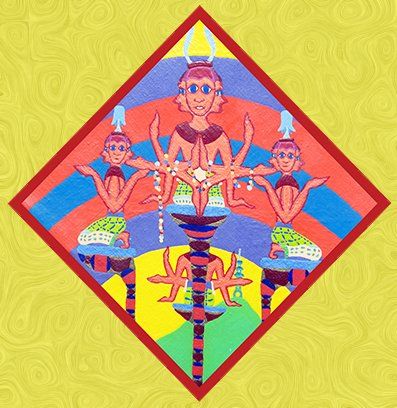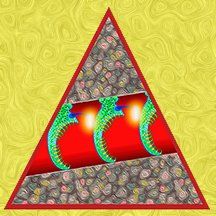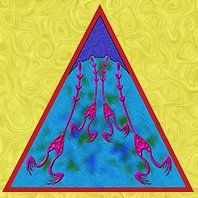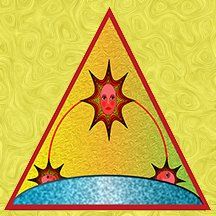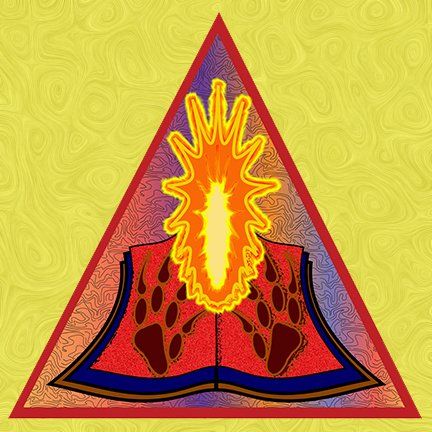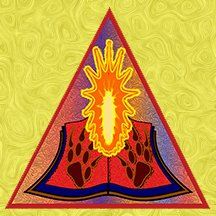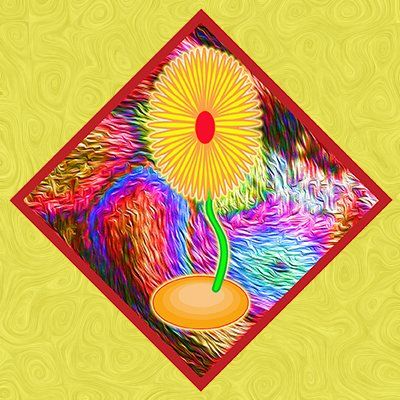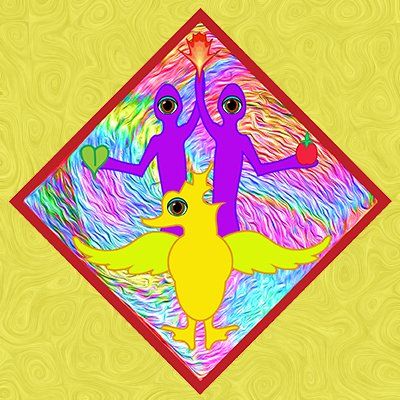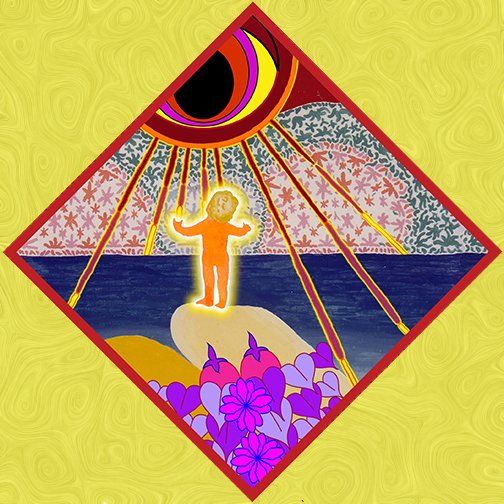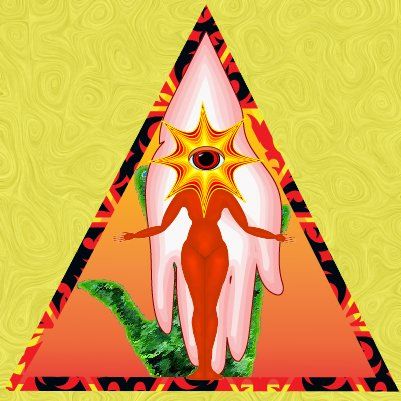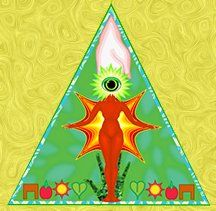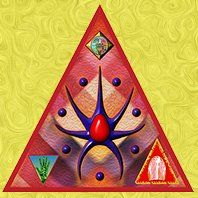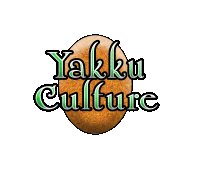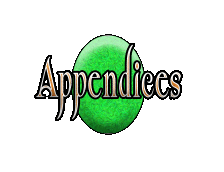
The Interim is a period of seven hundred and forty-one years between the fall of the Primary Epoch (Tolku Age) and the rise of the Secondary Epoch (Koru / Yakku / Yelda Age). These seven centuries were also the time of the Suvuka Domination Era of all Anu, their ‘Second Onslaught,’ meaning the destruction of most of the vast Tolku legacy. This page summarizes this period while taking specific themes beyond it.
Above is the Koru Icon for The Interim. Within this icon, two species fight for dominance. The Suvuka, who ultimately lost, is in the black mountain, their unique paw prints radiating from the realm of Raw Life, Indatubangus. The Koru’s mountain shows a blossoming Living Instrument, allowing for the perfection of Koru mountain life and ultimately their most significant achievement, the Yelda.
The Killing Swath
The First and Second Suvuka Onslaught
First Onslaught, The Vettencore Passage barrier, Killing Swath and Second Onslaught, Tolku of Thermistal and the Suvuka, Water defences, Stone Signal, Suvuka enter Statos-Vey for the first time
Koru and Yakku
Birth of the Koru, Thermistal survivors become Yakku, Initial Euphoria, Koru settlements in Thermistal mountains, Koru Yakku troubled relations, Incompatible visions, Yakku response to Koru Majastas
Suvuka Extinction
Majastas Zudaz-Vozev releases the venom, Yakku vengeance, Suvuka end around Lake Teval
The Past: Amassment and Treasuries
Mount Midin during the Lesser Era of the Primary Epoch, Mount Midin during The Interim, Scope and nature the Amassment, Alarm sounded, Pauloman Catalogues, Ancient dynstic collections, Mount Midin tragedy, Treasuries discovered, Curious design of Parayad and all Treasuries, Extent of Treasuries, Thirty-two in number , Insect icon formations , Initial delay in opening , Place of pilgrimage for early Generations, Mount Midin Amassment further delays opening of Treasuries, Amassment tragedy stops all Treasury activity, Discussions prior to first crate opening, First three crates opened, List of contents first mystery, Boustrophedon text concerning Dream Guides, Unpacking the crates, Sequestering of crate contents, Shocking results of examination, Melodramas and homilies, Blossom Benisons, Majastas Exegesis volumes, Miraculous tales of ‘Comely Children,’ Atmite Treasury, Confusion and contention, Treasuries closed, Treasuries reopened in 577, National Maturity, Tolku Proclamation
The Future: Yelda
Autonomous Hybrids, Yelda Generational Plan, Yelda distinct presence within the System, Island of Tich-Tushmul, Danam Yelda
A desperate solution
What is known of the nature and extent of the Killing Swath is detailed here. The Primary Epoch, was characterized as an immense span of peace, health, and prosperity based on surviving evidence. It ended in horror and flames. With so little known, there is much speculation. Early in the Secondary Epoch a singular document, known as the ‘Tolku Final Proclamation,’ was found dating from as close to the end of the Primary Epoch as anything surviving. Profound scholarship covers this elaborate text. While many references remain obscure, it clearly states the Primary Epoch was ended to save the Living System of Tatchlan from a host of terminal maladies. It could not be remedied otherwise.
First Onslaught
To understand how the Primary Epoch ended and the Secondary Epoch began, we must understand the difference between the First and Second Suvuka Onslaught. The First Onslaught took place just before the commencement of the Greater Era of the Primary Epoch. The Suvuka swept down Rho-Jashun, destroying the ancient civilization of the Muraharoma Dynasty and its fabled capital, Thithanu, in central Rho-Jashun within the shadow of Mount Thuma. Remnants of the Imperial family and administration fled behind the ‘Impenetrable Barrier Region,’ the southern wall of Mulungu Mountains separating the continent's southern coast. Due to preparations, this natural barrier was fortified in critical locations, and the Tolku on the south side was successfully protected. Most survivors migrated onto Statos-Vey, and the resulting population concentration led to many changes in Tolku culture. Full details about this period and everything occurring before the Living System Quickened and the arrival of the first Tolku Majastas may be found on the Pre-Tatchlan page.
When the Tatchlan Masters, led by Master Duamang, successfully broke Suvuka power by rendering them barren, the Suvuka headed north and crossed back over to northern Thermistal. A united Tolku force followed closely behind them, with others landing all along the southern coast of Thermistal.
Due to many other innovations the Tolku devised during the occupation of Rho-Jashun, the uninfected Suvuka of Thermistal were surprised and defeated in several battles. Eventually, all Suvuka herds were forced to retreat east. The Tolku confined them to the South and East end of the continent of Thermistal and successfully held them there.
This eventually led to an entire Suvuka Domestication Ministry; the icon above right was the ministry's official emblazon. For most of Tolku's history as a Cluster-of-Clusters Nation, the Suvuka joined all ranks of Cousins as loyal servants, companions and pets of the Tolku.
Killing Swath and Second Onslaught
Unlike the Suvuka’s First Onslaught, the Second Onslaught met with little or no resistance. When the Killing Swath equally ravaged the Tolku population and their loyal Suvuka throughout Anu, the remaining raw Suvuka, unaffected by the plague, appear to have realized their opportunity and crossed the Vettencore Passage in Year Seven of The Interim. While the defences and obstacles were formidable, with no force backing them up, they swam the Vettencore and scaled the walls before beginning the campaign with a sweep across Thermistal. They found most of the Tolku population dead and destroyed any survivors they found without mercy.
They systematically tore down every construction, and witnesses reported they enacted special cruelties on the few remaining domestic Suvuka they encountered. The few surviving Tolku fled west ahead of the hordes, and those arriving at the vast forests of Western Thermistal took it upon themselves to scale the mighty trees found there. Only a few ships carrying survivors crossed the Panchala Sea and joined those in the Mulungu Mountain Sanctuaries. Most Tolku survivors had little choice but to remain on Thermistal. More on the fate of those survivors follows below. The last days of the Tolku on Thermistal come down to us in accounts written long after the events on Rho-Jashun, as well as oral traditions of the Yakku on Thermistal.
Tolku of Thermistal and the Suvuka
Remarkably, a handful of accounts survive within Mount Rongu on Rho-Jashun from those who saw the Raw Suvuka breaching the Vettencore Passage before they began their campaign to possess all of Thermistal. They agreed this took place in what would become Year Seven of The Interim. These surviving Tolku remnants would eventually become the Yakku. They began arriving at their refuge within the Viracocha District in Year Eleven of The Interim.
The first waves of Suvuka crossed over the Silvasora Mountain passes to attack them in the Year Fourteen. It took them seven years to cross the Kukernef Desert to the South of the Mandeca Mountains and spread over the Lake Teval basin before finally arriving at the ‘Three Gates’ of the Silvasora Mountains. Geography and aggressive attacks by the Tolku, now living in the Estates of Viracocha, armed with new weapons and strategies, halted their advance. This successfully broke the Suvuka’s momentum and resolve.
The Suvuka did not cross over the Panchala Sea by various means to land on the Huallapandu Headlands of Rho-Jashun until Year 85 of The Interim. They began their campaign to destroy all traces of the Tolku on Rho-Jashun in the Year 87 and did not enter Statos-Vey until a century after The Killing Swath. This initial delay in WesternThermistal allowed the Rho-Jashun survivors to recover, organize and enact their plans. As detailed in the ‘Final Tolku Proclamation ,’ there was a vast project and mission for the survivors. It was foreseen that the Raw would overrun those still living, and thus, preparations for ‘Sanctuaries’ within the Mulungu Mountains of Rho-Jashun were instituted.
Water defences
During the First Suvuka Onslaught, the Suvuka’s curious reticence to attack structures founded on water, such as bridges and a few minor structures built on small islands, was noted. This insight was remembered at the end of the Primary Epoch. After the Killing Swath, the Tolku survivors followed clear signs set up for them across Statos-Vey and Rho-Jashun. Their destination was several refuges on Rho-Jashun, primarily the Chraxan, Rongu and Arnom Mountains. Appearing to know the Suvuka were coming, they swiftly diverted rivers to create pools of water in front of fortified and camouflaged entranceways before the Suvuka began their second charge across Rho-Jashun. These survivors were later known to belong to the First, Second and Third Generation, comprised of travelling groups joining together to arrive in a series of generational waves at the Sanctuaries. The First Generation reached safety a decade or two after The Killing Swath; the Second and Third generations were born on the terrible road to reach the Sanctuaries from all over Anu.
There are incomplete tales of heroism and sacrifice from those who reached Mount Chraxan and other mountains. Once established in these Sanctuaries, they celebrated the Fourth Generation, born within these mountains, who risked death to venture out and rescue Living Instruments, Primary Epoch Attainments, and other vital resources. These were gathered to ensure Tatchlan and precious civilization did not fall into complete ruin. There were many terrible decisions. Notably the deliberate exposure of the most-ancient Midin Mountain Legacy to destruction to draw Suvuka hordes away from secret population centres, also on Mount Midin, so that they could be successfully evacuated south to Mount Arnom. ‘Crossover Servants,’ being Recovered Ones whose deep conditioning survived the Killing Swath intact, included the Cousins, particularly the Varku, and the aerial Krall. The latter began to be employed by the first Invocates as ‘Eye Windows’ to monitor Suvuka herd movements. The Varku below and the Krall above often accompanied this Fourth Generation on their dangerous missions, serving in reconnaissance and defence roles.
Stone Signal
These signals are a vibration language developed as a warning and communication technique within the Mulungu Mountains against the Suvuka. It involved sending complex audio patterns through the walls of what would become Koru mountain communities. This innovation grew into a specialized skill that considered the different compositions and densities of stone through which the signal was sent. It continued to be extensively employed up to the first Koru Majastas. With the later growth of the Living Mountains, its use diminished. During the breaking of ties between the Yakku and Koru of Thermistal early in the Secondary Epoch, employing these signals facilitated the flood of Yakku refugees escaping to Rho-Jashun. Later, the phrase ‘using stone signals’ and other variations became a polite term for less sophisticated populations dwelling outside the Living Mountains.
Suvuka entered Statos-Vey for first time
After overrunning eastern and central Thermistal and, after considerable delay reconquering Rho-Jashun, the Suvuka’s Second Onslaught accomplished what the First Onslaught did not. They entered the subcontinent of Statos-Vey by successfully breaching what had been known in most-ancient times as the Impenetrable Barrier Region of the southern Mulungu Mountains at what is now known as the Thumondu Broken Wall Monument. They also eventually crossed the Xaduron Walls along with the now-unguarded Bulbogal Trench along the southern spur of the Mulungu Mountains. For the first time, they crossed into Statos-Vey and razed to the ground all physical evidence of the Tolku civilization they could find throughout the subcontinent.
The Suvuka ruled the two continents and subcontinent for seven hundred and forty-one years. The two remnants of the former Tolku recovered and finally rose as new beings, the Koru of Rho-Jashun and Yakku of Thermistal. Each eventually defeated the Suvuka. The first Koru Majastas, Zudaz-Vozev, wakened the ancient weapon of the Venerable Master Duamang from within the Living System. This lead to the Suvuka's eventual extinction. Master Duamang had ended the first Suvuka Onslaught at the beginning of the Greater Era of the Primary Epoch. Now, with the termination of the Suvuka threat, Majastas Zudaz I launched the Secondary Epoch.
Despite their reckless antipathy to all things Tolku, as the Secondary Epoch progressed, much was found the Suvuka overlooked. Small pockets of survivors continued in several locations for generations before succumbing to the Suvuka hordes or successfully reaching the Sanctuaries. In one case, a city named Turace, in the far West of the southern Mulungu Mountain range, appears to have been completely missed. It remained peacefully abandoned as a noble ruin until it was rediscovered during the reign of Majastas Zudaz II. A few years earlier were marked by the uncovering of portions of the port capital of Bhampay that had been artfully camouflaged and remained hidden from the Suvuka. Details of this event appear in the second novel of this series, Amarel Mountain.
Birth of the Koru
By ways still little understood, the Killing Swath changed the last generations of surviving Tolku. Those taking shelter within the Sanctuaries began to undergo alterations with each new generation. This was noted in documents dating from the Year 89 of the Interim, two years into the Suvuka Onslaught of Rho-Jashun.
The Guardians became notably larger and preferred withdrawing from Nu’s gaze. As a result of their increasingly nocturnal existence, their skin grew increasingly pale, eventually leading to later generations being pure white. The consensus among Honoured Historians is the First and Second Generation were Tolku, with the Third Generation showing clear signs of change. The Fourth Generation is seen as early Koru. They agree that the rebuilding and reawakening of all aspects of the Resplendent System are the work for the first Koru.
Mount Chraxan contained extensive grottos and connecting passageways now expanded and modified for long-term habitation and defence. This allowed for the most significant gathering place of refugees. Tradition holds that Chraxan was the cradle from which the last Tolku would see the birth of their altered children, the Koru. In later ages, This White Hand icon came to stand for all Koru.
Thermistal survivors became the Yakku
While the last Tolku and succeeding Koru huddled within the mountain Sanctuaries of Rho-Jashun, to the north across the Panchala Sea, small groups continued to find refuge in the tall forests of Western Thermistal. There is no surviving lore about these groups finding signage set up before the Killing Swath. One fragment suggests such directives did exist, and it was not intended for them to remain on Thermistal.
This document claims they were urged to sail across the Panchala Sea to join the others within the mountains as part of the last Generational Plan the final Tolku Majastas carried out. Apart from this single partial document, little evidence remains as to whether more than a handful of ships managed to cross the Panchala Sea and arrive at Mount Chraxan on Rho-Jashun.
The Killing Swath, and the swiftness of the Second Suvuka Onslaught may have disrupted any escape infrastructure. This disarray among the still suffering few survivors precluded much subsequent organization and planning on Thermistal. This left the surviving Tolku with few options beyond fleeing West before the Onslaught across the continent toward the arboreal refuge in the western forests of Thermistal. There, they encountered an unforeseen rescue.
Within those vast forests continued a remarkable surviving remnant of the Primary Epoch, the Viracocha District Flora Ministry. Details of the singular story of this surviving institution and its revitalized purpose after the Killing Swath are on the Yakku page. The presence of these highly specialized and well-resourced populations within these mighty forests ensured not only the survival of most of those reaching this fortified refuge but also the tools to turn and fight the Suvuka. Of necessity, all these Tolku found themselves making a new life up in the trees for several generations until the threat receded. By this time, they had become distinctly new beings, the Yakku.
As with their Rho-Jashun siblings, the Tolku of Thermistal were altered by the legacy of The Killing Swath. In their case, their bodies lengthened along with the digits on their hands and feet. They formed a close alliance with the arboreal cousins, the Asaku, Mayku and Tecku, along with to a lesser extent those able to ascend into the trees out of necessity, the Patzku. They evolved into a new arboreal culture, seldom if ever touching the ground. While initially out of necessity to avoid the Suvuka who hunted them, they remained out of a growing preference to do so. When the Koru crossed the Panchala Sea halfway through the Suvuka Dominion and discovered the Yakku, they fashioned The Green Hand emblem for them. These Yakku Emblems were the only Koru design showing the Mountain Border inverted to symbolize the equal status of the Yakku, yet also their profound differences from the Koru.
Initial euphoria
Nighttime sailings begin from the coast of Rho-Jashun on the Panchala Sea. The Koru explored the northern coast of Rho-Jashun and eventually crossed over to the southern coast of Thermistal. There, they discover a group of Yakku. Despite their differences in appearance, both immediately recognize each other as descendants of the Tolku. The Year 178 of The Interim begins what is now termed the ‘Happy Century.’ This was an ecstatic time for both communities. Groups of Koru stay with the Yakku on Thermistal, even venturing into their forest cities, although they have significant difficulties with the heights and exposure. They travel through their forest kingdoms and survey the land beyond under cover of darkness.
Groups of Yakku sail back to Rho-Jashun to witness the wonders of the Koru’s mountain civilization. They bring seeds of their mighty trees. They are planted with ceremonies towards the day some choose to live with their relations in Rho-Jashun. Each also presents gifts to the other of their craft and knowledge to repel their common enemy, the Suvuka. They also exchange artworks, salvaged Attainments from the Primary Epoch, and epics and songs of their trials and Secondary Epoch history. One instance entails the enrichment of the Koru’s pharmacopeia by the Yakku’s medicines and other powerful agents from their long work with the trees and plants of Thermistal. During this beloved century, innumerable couplings between Yakku and Koru also led to offspring who distinguished themselves as a unique hybrid of each. They came to be called the Yelda.
Koru settlements in Thermistal mountains
In the Year 191 of The Interim, some Koru moved and settled in the western Viracocha Mountains of Thermistal, six thousand andas east and north of the Central Triumvirate. To a lesser extent, they also settled in the Silvasora Mountain chain of Central Thermistal, on the western edge of the Lake Teval basin. While this led to growing prosperity for both populations, it also initiated a class division within Yakku society. The Yakku organized themselves into ‘Regional Trees,’ and the capital of each formed a significant urban culture.
The Koru never had a rural culture and naturally focused on these population hubs. They invested time and skills, trading and exchanging ideas and culture while continuing to have relations with the Yakku, leading to new populations of Yelda. This led to a thaw in relations among Yakku elites and suggested earlier rifts would heal with time. Unfortunately, outside of these urban centres, an increasingly hostile environment took hold based on the growing power of the Siv-Sa religion and a variety of other xenophobic movements. Unbeknownst to much of the general Yakku population, plans began to carve transit tunnels connecting these mountains to the Mulungu chain on Rho-Jashun, passing under the Panchala Sea. The transit lines linked these new populations with the Central Triumvirate and later the emerging Cluster-of-Clusters Nation. It later became clear they were also necessary to fortify an increasingly beleaguered Koru population when the Yakku overthrew their elites and turned against them.
Koru Yakku troubled relations
The above icon /emblem configuration reflects the early dealings between these two descendants of the Tolku. As detailed elsewhere, the Green Hand, full of vegetation rising to the sky, symbolized the Yakku. The White Hand goes down into the loam. The rock beneath embodies the focus and life of the Koru. After a century and a half of dealing with each other, tensions gradually built between Yakku and Koru on several issues. In the Year 322 of The Interim, eleven of the twenty-three Regional Trees banned their citizens from travelling to Rho-Jashun. An amiable debate on what was named ‘The Legacy’ by the Koru became a heated argument.
Most of the Yakku resolved not to rekindle the Living System on Thermistal. This caused a split, with a significant minority of Yakku beginning to sail south to live in Rho-Jashun. What were now forest Estates on the Marachla Plain were ideal for these emigres to populate. This caused fear and consternation among specific populations of Yakku of Thermistal, leading to wild speculation and paranoia. Another contentious issue concerned the Yelda and how the Koru modified their Yeldic populations. These notions were not universal, and many other Regional Trees condemned this action. Only two of the eleven Regional Trees had rescinded the ban within a century.
Incompatible visions
Honoured Koru Historians suggest a large portion of this was based on fear and envy of the growing power and wealth of the Koru, as well as resentment over their relatively easy security concerning the Suvuka. In fairness, the Yakku had developed a distinct culture that diverged profoundly from the Koru view of Anu in many ways. Their experience after The Killing Swath moulded them as much as it had the Koru. The result was two ultimately incompatible visions. The Yakku vision is detailed elsewhere. After centuries of love, the two descendants of the Tolku became divided by more than just the Panchala Sea. Within Yakku society, there were growing divisions between those following an anti-Koru religion, Siv-Sa, and those rejecting such beliefs. This was also, in part, a growing divide between urban and rural sensibilities on these issues.
Yakku response to Koru Majastas
The emergence of the first Koru Majastas, Zudaz-Vozev, produced a mixed reaction among the Yakku. Those Yakku supporting ongoing relations with the Koru were found primarily in the urban areas. They benefited the most from the ongoing trade, ideas exchange, and sharing of Yeldic offspring. Artists and academics sang praises to the Koru/Yakku alliance and envisioned a unification of the two descendants of the Tolku.
There was a widespread claim the advent of the
Siv-Sa religion, sparked by the death of the three youths inspiring it, originated in
the
same
day
as the
Mantle of Tatchlan enveloped this first
Majastas of what would become the
Secondary Epoch. While not, in fact, the case, this belief fuelled a slow-burning rebellion in the general
Yakku population. These Yakku feared the new Majastas, assuming the powers of the
Foremost Epoch Tolku. As the religion grew and the ages passed, their religious teachers developed a detailed analysis condemning the
Tatchlan System.
A surprising source significantly augmented this critique. It became clear that the writings of the most-ancient Tatchlan critic, Nebutan, had survived as they became available to this population. Her works enjoyed new publications and caused wide-scale controversy with each Yakku Regional Tree. More details are on the Yakku page. These simmering tensions remained below the surface until Zudaz I died and a new Majastas emerged. This made it clear that the Tatchlan line was established and would continue among the Koru of Rho-Jashun.
With the arrival of the second Koru Majastas, Zudaz-Vanoy, in 286 UKC of the Secondary Epoch, the last threads holding the Yakku Collective, with its many stratified divisions and tenuous alliances, would come undone. In less than a year, a series of dramatic incidents, many based on long-established subversive movements, led to the overthrowing of the Yakku elite structure and the previous accord between the Yakku leadership and the Koru Cluster-of-Clusters Nation. This revolution, and the long buildup of tensions throughout The Interim, are now termed The Rift. How these final actions unfolded in one Regional Tree is detailed in the second novel of this series, Amarel Mountain.
Majastas Zudaz-Vozev releases the venom
In the 64 of the Unbroken Koru Calendar (UKC), the first Koru Majastas, Zudaz-Vozev, recaptured the craft of the most-ancient Tatchlan Master Duamang and releases Her modified version of the Brangnam Plague in a series of potent bursts intended to render barren all Suvuka on Anu. The Koru had long laboured on reopening and creating new transit tunnels far underground throughout Rho-Jashun, Thermistal and even into Statos-Vey.
While the plague would progress naturally, these tunnels ensured their quickening occurred universally across Anu. Over the next sixty years, the herds on both primary continents and Statos-Vey were monitored. Within the first decade, no cubs are born, even in the far south of Statos-Vey and far north of Thermistal. Majastas Zudaz-Vozev continued to emit the craft in subsequent decades to ensure none escaped, declaring:
“Our history dictates we must expunge Anu of our former companion, ally and nemesis.”
Yakku Vengeance
Another area of contention between Koru and Yakku was the fate of the Suvuka. Even though the Koru Majastas dealt them a final blow, the Yakku took it upon themselves to issue out of their forests and pursue them eastward across Thermistal.
The remaining Suvuka were aging, weakened and demoralized. They fled before the united force of Yakku, who slew any who could not keep up with the retreating herds.
This action added to the growing rift between the Yakku and Koru, who saw this campaign as unnecessary and excessive. Despite their advantages, many thousands of Yakku perished, from encounters with Suvuka and the journeys' perils, which took them to Pramath Island on the far eastern shore of southern Thermistal. With the declaration of the extinction of the Suvuka, roughly half of the victorious Yakku took up residence in the smaller but extensive forests of eastern Thermistal.
The remaining Yakku made the long journey back across the continent home. The weak and diminished force only then realized that nearly half of the surviving Suvuka population had moved north around Lake Teval. Neither side had any desire left to fight and avoided each other.
Suvuka ended around Lake Teval
When the Suvuka determined their fate, those on Statos-Vey and Rho-Jashun turned their eyes towards Thermistal. They made their progress through Statos-Vey and Rho-Jashun to the Huallapandu Headlands, also named ‘The Crown’ of Rho-Jashun, to migrate across to their most-ancient homeland. Out of respect, the Koru withdrew and allowed them to proceed without hindrance.
Their sudden arrival on the south-western coast caused a stir among the
Yakku. Their society was divided between those knowing the Suvuka were doomed and allowing them to die away and those determined to exact vengeance. This debate revealed
many divisions between elders and youth, urban and rural, more educated and less so. Some of these divisions persisted for a generation, leading to deeper rifts brought about by the
Siv-Sa movement. Many thousands of Suvuka were killed as they landed on shore, while more made their way to the centre of the continent. Division appears to have arisen among the Suvuka. Some, it seems, desired to end themselves around the shores of their sacred
Lake Teval. Others chose to fight the Yakku, perhaps to lead them away from those wishing to make their end peacefully.
It is also thought they held the eastern shore in general, and Pramath Island in particular, in high regard and chose to fight to the last to defend these sites. Both hostile forces moved east while the rest gathered around the northern shores of Lake Teval. It was known that the Island of Lewetar, located at the north end of this vast freshwater lake, had always held special significance for the Suvuka. The Yakku eventually discovered this remaining population but chose to leave them be. A century later, the Yakku moved east to find thousands of bones mixed with the lush vegetation all around the shores of the lake. Their tradition holds the last survivors swam over to Lewetar to end their lives on what was presumed to be their sacred island.
Mount Midin during the Lesser Era of the Primary Epoch
Mount Midin stands in the Mulungu Mountains in present-day District Three, the Ronthum Interlaced Dependency, of the Koru Cluster-of-Clusters Nation on Rho-Jashun. This mountain is north and west of the three peaks of the Central Triumvirate of Mounts Arnom (District Five), Rongu (District Six) and Chraxan (District Seven). Mount Midin far predates those foundational three Sanctuaries of the first generations of Guardians.
Midin’s story extends back to the third unification dynasty of the pre-Tatchlan Lesser Era of the Primary Epoch. The short-lived Midin Dynasty established it. For reasons unknown, this dynasty chose to develop a vast archive of historical and documentary material deep in the natural caverns of this mountain. The succeeding Yin-Vinulan Dynasty augmented the collection. No satisfactory explanation exists for why such an exhaustive collection was established in this remote location. This has led to a significant amount of speculation.
Mount Midin during The Interim
After the Killing Swath, it appears some Guardians were aware of this famous site. Still, necessity precluded the refugees from attempting to access it. The first Three Generations focused on developing a new community within the Sanctuaries. Even these sheltered enclaves had discoveries, notably the Treasuries. The celebrated Fourth Generation was the first to successfully breach the seals and step into the vast interior of what came to be known as the Midin Amassment. This was shortly after the year 100 of The Interim.
They needed to be equipped to begin exploring this enormous inheritance but made a preliminary assessment. While the structure was mostly intact, the interval between the last Tolku stewards and their arrival meant portions of the collection were in danger and required expert care. They could then seal a few cracks and clear some debris. The scale of the task and ongoing peril of travel to Mount Midin meant a century passed between the initial discovery and the completion of extensive work to make the space secure, accessible and habitable. During this time, a small army of Varku, attended by all other classes of Cousins, were brought to the site to engage in clearing accumulated filth and attending vermin from the entire structure. They also engaged in the extended repair of many instances of structural damage. These early Koru trained the Varku in drilling extended thin ‘channels’ from the interior to the surface through the rock.
Once completed, new colonies of the early Koru innovation, the Gomuun, were introduced. The Gomuun maintained the desired air quality in ways the Suvuka could not detect. Humidity was also addressed by the large-scale introduction of Skayo, which had only recently been shown to be beneficial in controlling moisture levels in the Sanctuary grottos. With minimal supervision, this was one of the earliest claims to the honour accorded to the Varku for their tireless dedication and service. It also demonstrated how the ancient Tolku Majastas successfully augmented their brains to perform such complex tasks.
Scope and Nature of the Amassment
After a 658-anda tunnel was completed connecting Mounts Arnom and Midin, a long caravan of those clusters trained in the library arts, their service clusters, and an abundance of supplies traversed this distance to establish a permanent estate within the mountain and begin their assessment. They were charged with commencing the generational task of making the Midin Amassment available for extensive enquiry and becoming one of the pillars of the future state. Eventually, this modest group of clusters, known as the Pauloman, was founded late in 200 of The Interim. This was twenty-two years after the discovery of the Yakku on Thermistal and nine years after the first Koru settled in the Viracocha Mountains. A supply line stretched back to Mount Arnom, making this the first significant expenditure of resources on a single project of its kind in The Interim. This tunnel became the only safe and secure communication link between the two communities.
Alarm Sounded
The Pauloman clusters almost immediately reported an alarming amount of the collection was in poor condition due to extended neglect. Twenty percent of the material was significantly degraded, with a further ten percent beyond salvaging due to prolonged exposure or predation. Work on the Treasuries was suspended—all those with the necessary skills and expertise were diverted to Mount Midin. Emergency facsimiles were commissioned for work deemed too fragile to move from their location.
Pauloman Catalogues
Despite all these difficulties, a sufficient inventory, known as the ‘Pauloman Catalogues,’ of the surviving seventy percent of the collection was completed in the subsequent forty years. The Amassment focused more on agricultural, medical, legal, procedural and technical documentation. The catalogue was reproduced, showing extensive work to note each item, its date of inclusion, and often supplementary material about the donors. It must be noted that among this seventy percent of the collection, very few volumes did not bear some damage from their long wait for the Koru to find them.
Ancient dynastic collections
A sizeable portion bore various official stamps of the most-ancient Buyanupithar Dynasty. During the succeeding Midin and Yin-Vinulan Dynasty’s tenure, most materials related to the arts and literature were added. During the Yin-Vinulan Dynasty’s reign, they commissioned an immense series of specialty encyclopedias covering most aspects of pre-Tatchlan life on Anu. First editions of this voluminous material were given pride of place within the Midin Amassment. These colossal series were emblazoned with the ‘Nu as Complete’ emblem of most-ancient times.
The growing clusters of Pauloman became masters able to serve the many Koru enquiring after specialized instruction and reclaiming of Primary Epoch science and craft. Of note was the discovery of an unlikely volume of ten satirical plays known as the ‘Everlasting Ennui.’ It survives to the present by good fortune to become this collection's single most well-known artifact.
Mount Midin tragedy
In the year 240 of The Interim, the Suvuka broke through the defences of the Pauloman clusters. They slaughtered 2,557 Koru, both among the Pauloman clusters and many visiting the Amassment at the time. The death toll would have been far higher had not a small group of Koru, accompanied by hundreds of Varku, diverted the Suvuka to follow them away from the far larger population and into the Midin Amassment itself. There, the rampaging savages set about destroying the entire Amassment while the remaining Koru escaped back to Mount Arnon, most carrying whatever they could of the ‘Midin Mountain Amassment’ on their backs and in their hands. They also brought stories of how the last escapees witnessed Suvuka somehow causing a fire that swept through the interior.
This was the single largest massacre during The Interim, and few clusters within the Central Triumvirate were left untouched by some treasured circle, or sole cluster-mate, lost that night. Despite having access to this collection for forty years, all mourned the demise of the most complete and exhaustive legacy from the Primary Epoch.
After an extended pause, expeditions finally returned to find the Amassment an utter burned-out ruin. Excavations were carried out, revealing only a handful of surviving charred volumes. The outpouring of grief took many forms and is memorialized by several notable literary and musical masterpieces from that time. An estimated eight hundred volumes were already outside the Amassment at the time of the tragedy. The survivors brought an additional two thousand volumes. The surviving Pauloman Catalogues make clear this is a tiny fraction of the Midin Mountain Amassment.
Treasuries discovered
Long before the Mount Midin Amassment, a very different inheritance was uncovered within the three Sanctuary Mountains of Chraxan, Rongu and Arnom. The First Generation of Guardians discovered chambers set aside, sparsely furnished and containing stored supplies. Each of the three mountains included at least one of these grotto complexes marked to those following the signs into the Sanctuaries.
While subsidiary chambers were located subsequently, these principal chambers were the largest and most well-appointed. Within each of these networks, they found a curious entranceway. It took some time and considerable craft to devise their opening, but once accomplished, an even more unusual structure awaited them.
Curious design of Parayad and all Treasuries
The doorway opened into a passageway, wending away into the mountain. Mount Arnom’s passageway was the longest of the three. They each led to a large circular domed chamber with a single word carved into the walls. In the case of the Mount Arnom Treasury, this was the unknown name ‘Parayad.’ Two staircases dominated this chamber, composed of sixty-four steps carved out of the living rock. They followed each other in a diminishing spiral pyramid to the dome, which ended at the circular hatch. When opened, this lead up through a full aperture into an even more anomalous construction. Those emerging from the staircase found themselves inside what initially appeared to be a mystifying interior. Further investigation determined this cavity to be the giant hollowed-out version of the insect icon. As if the mould for a monumental image, the Parayad Treasury took the form of the ‘Wise Spider Glyph’ of pre-Tatchlan times, also the standard representation for the Mahakram spider tree colonies.
Her body formed the central space with four tunnels for her long legs leading off on either side. While some magnified surface features of the insect’s hide were visible, the main feature was between one and three hundred cavities carved into these walls. Each contained a crate just fitting into it. Thick resin coated these crates. Skin Touched, able to employ their specific powers to ‘reach through’ physical barriers and ‘feel’ what lay beneath, were brought in to examine them. They reported that the crates appeared to contain tightly packed collections of books, manuscripts, and sheaves of papers. These collections received approximate dates from the last millennium to the previous century of the Primary Epoch. These materials were carefully inserted to minimize deterioration, surrounded by insulation and moisture barrier wrappings. In some Treasuries, depending on the insect shape they assumed, most of each Treasury's crates filled the cavities in the leg formations. This Koru icon illustrates the unique nature of these sites, with a set of books appearing composed of stone and the Ketukku classes carved into their pages.
Extent of Treasuries
Once the original three Treasuries were discovered, and the Koru extended their domain throughout the Mulungu Mountain chain, they became adept at identifying the other twenty-nine Treasuries for a total of thirty-two spread across the Central and Southern Mulungu Mountain Range. Given their entranceways were recognizable and the now well-known locking mechanism well understood, they made short work of accessing these additional chambers. These continued to be found throughout The Interim, with the final discovery early the first Koru Dynasty of the Secondary Epoch, these continued to be found. The southernmost was within Mount Chaxran in what is now District Six, the Bangkur Interlaced Dependency. The northernmost Treasury is named Gashandak (home of the famed Abridged Encyclopedia of the same name). It is located within what had been known as Mount Lumol, in what is now District One, the Kupataron Interlaced Dependency, over seventy andas north and east of the first of the Koru Living Mountains, Kupat Queens One. Except for the three Sanctuary Mountains, all host mountains were renamed after the Treasuries they contain. These hidden structures were not discovered in order, and some more remote locations remained hidden until the first decades of the Secondary Epoch.
Thirty-two in number
It is now unlikely any additional Treasuries will be found. A simple listing was found in the first discovered Treasury, the Parayad. It was a small sheet containing all the names of these structures in apparent order of sealing, although no dates were provided, with Parayad being last. No coordinates were included, leading to an extended period of discovery. There are partial lists found in two other Treasuries, only confirming the order of the final one.
Half of the thirty-two Treasuries resembled one of the eight classes of Ketukku insect colonies, which would assume an even more profound significance for the Koru Cluster-of-Clusters Nation than they had for the Primary Epoch Tolku. Along with the Parayad Treasury's distinct formation as the Wise Spider , seven were shaped similarly to the Mahakram icon. Four Gandahatapan Treasuries remained, with extraordinary carved-out wings on either side with their crates buried in the floor, two Vikavan and two Teer Beetle Treasuries. No correlation has been made between the enclosure's symbolic nature and the crates' contents. The disposition of these Treasuries across the Mulungu Mountains appears to be random. Any class of Ketukku Treasury could have a Mahakram to the north and a Teer Beetle to the south. When two Ketukku Treasuries were found in proximity, they were out of sequence. No apparent criterion for the distance between these Treasuries has been discovered. The next in the series could be less than one hundred, or many hundreds of andas away from its predecessor and successor. While there are minor signs of improvement in the design of later Treasuries, they are mostly consistent in layout and artistry. Other than these lists, no document has yet been uncovered detailing the background behind this ambitious project. No separate document mentions these Treasuries in any way.
Place of pilgrimage for early Generations
For decades, these three Treasuries became a pilgrimage site. Certain ceremonies, particularly around rites into cherished Ripe Adulthood, took place there exclusively. Initial documentation of these events at the time does not mention today’s Koru having to bend over and the need to turn to one side when navigating these spaces. This suggests these Treasury activities commenced before The Change had begun. By this time, ancillary clusters had formed around the Treasury in what was now known as the Kodrapum Grotto. While they groomed themselves as the eventual openers of the crates, they dealt with another pressing matter. The volume of visitors sometimes exceeded the original Treasury ventilation shafts, and the newer channels for colonies of Gomuun, to clear the air for the unforeseen influx of visitors. Rising humidity levels called for more Skayo to patrol the roofs. The number of Gomuun channels drilled was doubled, and additional colonies imported to address the situation. This became standard at all thirty-two Treasuries.
Mount Midin Amassment further delays the opening of Treasuries
Upon the Pauloman Clusters' urgent communique early in the year 200 of The Interim concerning the terrible state of the newly discovered Midin Amassment, all preparations stopped on opening the first crate in the Treasuries. Those deemed ready for that task were rushed up to Mount Midin to assist in the rescue of a large number of mouldering volumes too long left unattended in a vast underground network of ancient caverns. It was judged the contents of the Treasuries were far more secure inside their crates and could wait until the far older, far more extensive and much more vulnerable collections were attended to.
Amassment tragedy stops all Treasury activity
With the Suvuka destruction of the Mount Midin Amassment and the colossal loss of life among the specialized Pauloman clusters just forty years after they had commenced their work. All plans to begin the process of opening the first Treasury crate were suspended. Once the all-clear was sounded, a new generation, poised to work on the crates, was dispatched north. They assisted in the recovery process at the ruined Amassment site. Beyond this, all excursions halted, and an intensive audit of all security procedures and protocols occured. Notwithstanding the many ingenious innovations and strategies employed in these first two centuries of their new existence, two facts remained.
The emerging Koru were still vulnerable. The Suvuka remained utterly implacable in their desire to exterminate them and anything they deemed works of the Tolku. The Amassment and Treasuries were set aside to allow for an acute focus on strengthening their security. So intense were these activities during this period that when a new Treasury was discovered, no attempt was made to open it. The Varku were formally lauded for their self-sacrifice and heroism during the attack. Their status was deepened, and these actions set plans for further augmentation within Tatchlan. It was eventually determined their fellow ‘Crossover Servants’ the Krall, had been spread too thin at the time of the Suvuka attack. This led to a tragic delay in seeing dangerous herd movements near Mount Midin. Specific ministries were reorganized, and new procedures enacted. These ensured the surveilling Krall flocks were better focused on Suvuka herd movements, and a more in-depth analysis of their trends was made. This information was used to make more accurate forecasts of Suvuka activity.
Discussions prior to first crate opening
Many intensive discussions took place before the first Treasury crate was finally opened. Why were such elaborate precautions taken in the creation of the Treasuries? None could deny the clear evidence that the three Sanctuaries were hewn to provide shelter to refugees after a catastrophe. This same evidence revealed the Sanctuaries’ fashioning predated most of the Treasuries. However, the contents of the storage chests, including dry goods and insulating fabrics, were laid close to the terminal event. The first Three Generation’s attest to signage across the post-Killing Swath landscape, making clear that a plan was enacted near the end of the Primary Epoch to ensure the Guardians reached these Sanctuaries. It appeared no provision was made to safeguard the immense Midin Amassment from any extended period of neglect. Why go to such lengths to preserve the Treasury material? After the Amassment Tragedy, debate intensified about why the two legacies received such disparate treatment. The extreme measures employed for the mysterious Treasuries could have also been implemented in part to at least save portions of this Primary Epoch material. Others suggested such an initiative did take place, and the Treasuries were, in fact, this salvaged material from the Amassment. Such beliefs grew, putting immense pressure on the clusters guarding the Treasuries to open the crates.
Venerable Scholars gleaned this summary with considerable difficulty from the scattered fragments of notations of the time. In light of the later discovery of the Final Tolku Proclamation, clearly stating the purpose of the Rectification and the articulation of the plan for the Guardians, the lack of all reference to these facts remains an enduring mystery. It is as if the Killing Swath wiped the Guardians of all memory of the circumstances leading up to their current situation. Notwithstanding this apparent forgetfulness, the Guardians adhered to all protocols in the Proclamation document during their unerring migration to the Sanctuaries and the program to rebuild Tatchlan.
First three crates opened
On the twelfth anniversary of the Midin Amassment Tragedy, in the year 252 of The Interim, the first crate was opened in all three of the original Treasuries. These were in the three Sanctuary Mountains of Arnom, Chraxan, and Rongu. The events took place simultaneously and were attended by the relevant academics, specialists, representatives of the pre-Majastas ministries of the emerging Central Triumvirate, and Invocates and Operants. They ensured the event was well known throughout the hidden communities. An array of Sensitives also accompanied them. In particular, a circle of Aroma Touched surrounded each crate to read the airs likely to issue out of them when opened. Specialized classes of Savant Touched joined them to lend their intense gaze to whatever the crates would reveal.
A short litany, initiated when opening damaged material in the Midin Amassment, was said over the crate, and then it was gently pried open. Despite some preliminary work to loosen the resin coating, some exertion was still involved. When opened, the Aroma Touched bent forward to sample the aromas issuing from it. They reported sampling sea air, strange floral aromas, and what could only be described as Tolku redolence! This was identified as familiar and different from the fragrances they knew, setting off a new series of enquiries regarding The Change, which all now noted. The Aroma Touched stepped back, and all the others leaned in.
List of contents first mystery
A clay tablet was laid, face up, on the top. On it was an incised list of the contents of the crate done with skill and elegance. Its inscription verified the interior was as the Skin Touched reported. This list proved of immediate interest. None of the titles were familiar, and a third appeared in languages unknown to any present. Even those who had studied the Amassment holdings over the past four decades were amazed. While a few were clear headings for recognizable subjects, most were unfamiliar names or terms. There was also a set of glyphs along the bottom none had seen before. This tablet was removed with great care and set in the first of a series of trays laid out for the contents. It was immediately removed from the site for a complete inspection and eventual reproduction.
Boustrophedon text concerning Dream Guides
The tablet had lain on a layer of insulating material. Beneath this was a tome filling the length and width of the crate. This was removed with exaggerated care despite appearing to be fresh and robust. This was in stark contrast to the best specimens within the Amassment. It was clear this collection was in pristine condition. Overcome with enthusiasm, at the Parayad Treasury, the first protocols were broken, and the mysterious volume opened. Its spine was surprisingly supple and allowed the opening with barely a complaint.
Inside was a strange image of a giant flower (this is a modern rendering) growing out of an egg done with considerable care. None knew what this might signify. The following page contained text in a diligent hand. While many of the words were familiar, none understood the subject matter. It appeared to concern itself with lengthy ritual preparations for courting beings known as ‘Dream Guides’ to be led to the ‘Lustrum Mirrors.’
It is now confirmed that the Guardians had also lost the knowledge of Lustrum Mirrors. This was the most profound of the most-ancient Practician's craft early in the Lesser Era of the Primary Epoch.
Beyond these unknown subjects, there was another surprise. Where the first line ended, the second commenced in the opposite direction, with all the text reversed. Observers were intrigued; they could still easily read the words while continuing to follow the meaning. The third line returned to the traditional orientation, with the fourth line in reverse. Eventually, this writing style was understood to be what was known as boustrophedon, once common on certain public monuments in the Primary Epoch. No examples of this exotic style used in a book were found in the Midin Amassment. Word of this discovery spread to the other two Treasuries by the Invocates and Operants, who found themselves departing from procedure to see what their first volumes contained. Word returned to Parayad, saying they also found themselves mystified by their different puzzles on the opening pages.
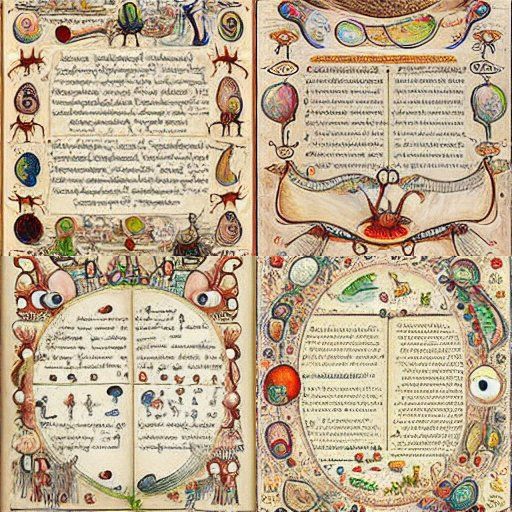
Unpacking the crates
The decision was made to return to the protocol. The mystifying text was closed and set in its tray for removal and study. The slow unpacking and unwrapping of volumes of various sizes intricately set in alternating vertical and horizontal orientations followed. The packing was seen as a masterwork, with different-sized books of varying thicknesses that were pieced together to fit perfectly in an unlikely construction. Notes began on the exact arrangement in each layer and their immediate neighbours, hoping to gain insight into any more significant purpose. Despite only twenty-two volumes inside the Parayad Treasury’s first crate and an assortment of loose pages, this was an arduous and time-consuming process. Finally, the last book was set in its tray and removed from the Treasury. The crate's interior was inspected, but nothing of interest was found beyond tiny fragments of paper and sand. The crate was repositioned in its niche, and the company exited the way it entered the Treasury.
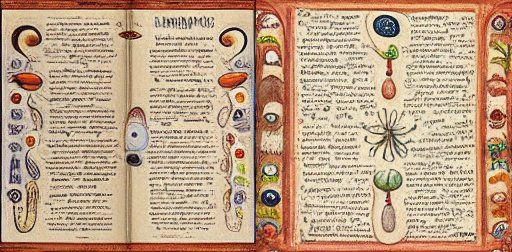
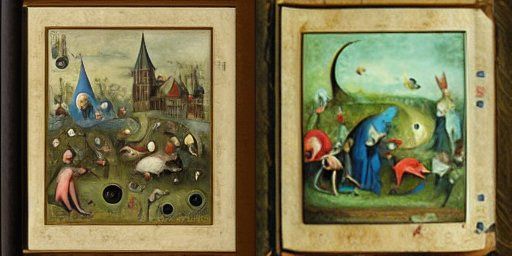
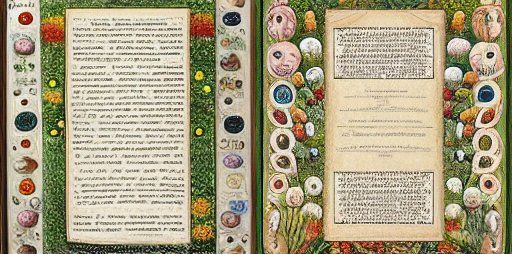
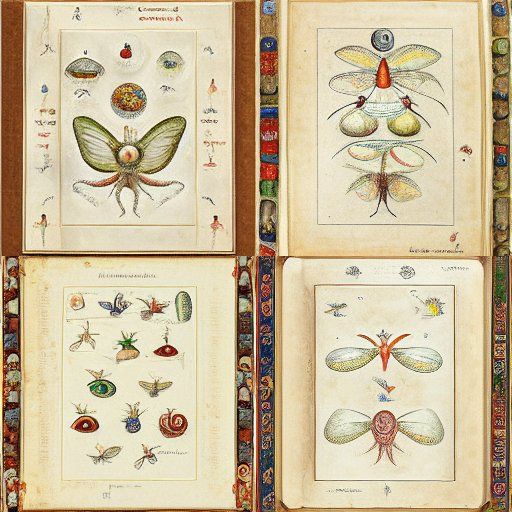
Sequestering of crate contents
A multitude of Venerable Scholars, Esteemed Librarians, Honoured Historians and their circles joined skilled calligraphers and other facsimile masters in isolated locations to begin their work. While maintaining lists of their original disposition, the works were divided by several criteria and sent to different groups for examination. For five years, they studied forty-nine tomes retrieved from the three crates. At the same time, meticulous facsimiles were made of each item. Both the known and unknown language tomes contained many pages of stunning beauty. An extraordinarily intricate play of wording and vivid illustration often swirled across these pages. All working on these volumes reported being mystified and mesmerized by these utterly bewildering compositions. The practice of reproducing two-page reproductions of the most exceptional and often mystifying pages began in this early period. They continue as display pieces to ponder in diverse Mantle Establishment and individual cluster settings.
Throughout the remainder of the Secondary Epoch, possessing a series of mounted reproductions from a vast selection of this work became a measure of distinction. Initially, it was presumed the reproductions of such elaborate works would consume more time. Still, the difficulty encountered in interpreting the material written in known languages proved far more than expected. All the unknown languages continue to be undeciphered. No connection has been discovered to living languages. Links to ancient language groups have yet to be discovered. Despite an abundant corpus from other Treasury collections, thus far, all attempts to translate this material have been met with failure. Speculation continues regarding whether they belong to some subgroup of fashioned scripts for specialized communities. In the year 257 of The Interim, their results were published nearly ten years after the extermination of the Suvuka on Pramath island by the Yakku. Only then were the limited editions of completed facsimiles released.
Shocking results of examination
The reports that finally arrived shocked academia and the wider society. Their findings were prefaced by the declaration that all the material was deemed to date from the late Primary Epoch. As such, the Treasury collections were not in any way associated with the Midin Mountain Amassment. The volumes were summarized as being largely unintelligible, many of them written in as yet indecipherable sigils. Those written in the standard language of the Tolku were still, with a few exceptions, mostly incomprehensible. The stranger pieces included manuals for what seemed utterly ludicrous practices, incoherent grimoires, enigmatic codexes, and compilations of fantastical tales with outlandish characters. Examples included an account of an ancient Majastas causing a group of Tamku to grow into colossal giants, while other related global battles between vast multitudes of tiny Sirintya and adult Kumastam. As with most of the rest, these were dismissed as fantastical myths.
Melodramas and homilies
Perhaps even more distressing, the most accessible material was poorly composed and seemingly infantile tales. Shockingly graphic and lurid illustrations accompanied some of these mediocre texts.
These were done with a high degree of skill, crossing all bounds and wildly overstating, as if in satire, the contents of the document they attended. Nothing remotely like this material had ever been found at the Midin Amassment. These authorities were at a loss regarding how to classify most of it. A few dared to quietly postulate this was evidence the Tolku had gone slowly and gently mad long before the Killing Swath.
Blossom Benisons
One of the few volumes held in some regard was titled ‘A Brief History and Summary of all recorded Benisons.’ This referred to what in most-ancient times as ‘Blossoms,’ which were kindly versions of what later became the terrifying Burning Blossom. These Blossoms were said to produce a wide variety of benefits, or ‘Benisons.’ They were actively sought after during their presence. While much of this work did not strain credulity, some sections appeared fabulous and extravagant. There was also a cultural inhibition in entertaining the notion of any advantage coming from Nu , particularly during his now-hated Burning Blossom phases. While later ages could divest themselves from this prejudice, those during The Interim period were held firm in its grasp and thus found this document presented considerable difficulties.
Majastas Exegesis volumes
To give one example, six large volumes appeared as part of an extensive set titled ‘Majastas Exegesis.’ There is ample documentation of ‘Majastas Annotations’ throughout the Primary and Secondary Epochs, but this collection constituted a viewing of such writings through a mystical lens. This Majastas Exegesis contained a collection of supposedly famous Majastas compositions, pronouncements and declarations (no independent reference to any of the Majastas named, or these declarations, have been found) with a convoluted methodology for the examination and interpretation of this material according to four defined levels of depth. Entire chapters were devoted to revealing descending levels of meaning in one sentence written by a Majastas. Despite their best intentions, those examining these works found they strained credulity with their bewildering and often excruciating observations. Each descending level became increasingly arcane and implausible. This unfathomable material was written in an exceedingly dry style and extraordinarily long sentences. On many occasions, individual words were given four levels of depth, changing dramatically with different contexts. Only a few Venerable Scholars could fully maintain their discipline in examining this material, and all regretfully came to the same conclusion. Beyond a historical curiosity, this material displayed how ancient cultures may occasionally become entangled in compounded errors, leading to absurd mystical constructions failing all plausibility criteria.
Miraculous tales of ‘Comely Children’
Another example involves several volumes in what appears to have been a popular genre of stories about ‘Comely Children.’ This term refers to the documented unusual births taking place years before the gentle and beneficial manifestations known as ‘Blossoms.’ Later, these would turn into Burning Blossom Cycles. What in subsequent ages would become the tragedy of ‘Strange Births,’ were, in these happier times, beautiful infant wonders.
Some of the tales were unusual but still entirely credible, including those about mighty Spokes of Cluster Wheels and the proliferation of precious Geniuses and other Living Jewels. Unfortunately, most accounts were deemed outlandish and extreme by those examining them in The Interim. Examples include tales of children able to swallow entire Hungry Rock only to spit them out at new locations. Others speak of children capable of morphing into other animals, sprouting wings, flying, and living with fish beneath the ocean. As such, these collections were treated as largely or entirely fiction. (This image is a modern rendition)
Atmite Treasury
This was the nineteenth
Treasury
and was, in many ways, unique. More than half of its contents were taken up by an enormous series of volumes titled the ‘Conceptual Lists.’ This was the product of generations of what had been known as the ‘Jemnum
Apprehenders,’ a specialized branch of
Honoured Historian
delving into the history of each thought and following it through history in what they termed
‘Concept Filaments.’
As with most of this Treasury collection, considerable frustration attended all attempts to read this material, in this case, due to an immense abbreviation system meant to refer to hundreds of thousands of separate
Greater Epoch events for which there is no surviving key.
Confusion and contention
This news shook the general population in many ways. With the loss of the Midin Mountain Amassment, great hope had been placed in these well-preserved Treasuries. With the reports widely circulated and the facsimiles and simple text versions available in many locations, speculation and argument over every aspect of these works commenced. Some argued these volumes must represent the profound depths of the late Primary Epoch, and the current generation was too shallow to comprehend them. They said no comparison should be made between the prosaic works of the pre-Tatchlan Midin Amassment and the rich work of the latter ages of the Greater Era. In the future, this would become known as the ‘National Maturity’ position on this legacy. Others took the opposite view, suggesting there must have been some taboo in the late Primary Epoch period against destroying even ridiculous texts, and thus they were elaborately buried. While everyone was baffled, most refused to believe the Foremost Ones would go to such lengths to protect worthless material. This left them with the challenge of trying to make sense of what for the time remained obscure.
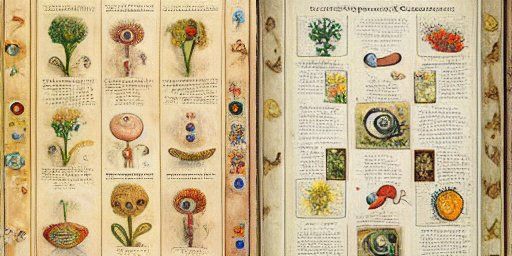
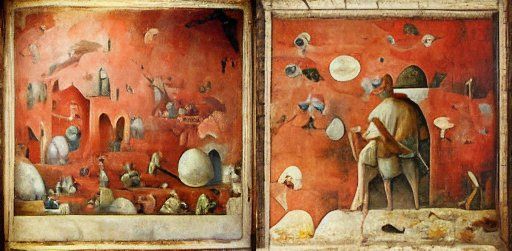
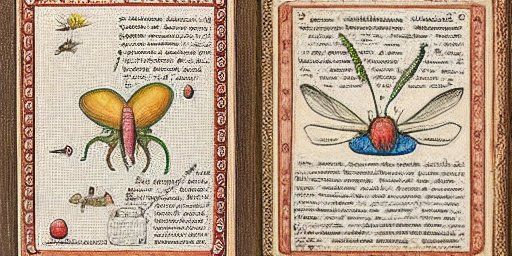
Treasuries closed
In the year 277 of The Interim, twenty years after the first reports and publication of texts and production of facsimiles, the Treasuries were sealed. The ruling was they would remain so for the foreseeable future. Much else occupied what was now seen as the Koru nation. For almost a century, the Koru had come to know and love the Yakku, only to suffer the pain of their growing alienation. Their shared children, the Yelda, now blossomed into their fullness, leading the Koru to envision a radical new future for both themselves and these Yelda.
Treasuries reopened in 577
The Treasuries were not reopened until the year 577 of The Interim. The process was slow and uneven. It was deemed necessary to come to an understanding of what had been set aside with such care. For the remaining one hundred and sixty-one years of The Interim, this prolonged process continued, and the first Koru Majastas of the Zudaz Dynasty reaffirmed their importance in the first decade of the Secondary Epoch. A ten-per-year quota for the opening of crates was established, although, on many occasions, not as many were opened due to external circumstances or internal challenges. This regime continued with some interruptions until all thirty-two Treasuries were finally empty by the year 806 UKC, five hundred and twenty years into the reign of Majastas Zudaz II. Many uncovered works were celebrated as having immediate value. One example was the ‘Gashandak Treasury Abridged Encyclopedia,’ which now is the most detailed source on many aspects of the Pre-Tatchlan and the Lesser Era of the Primary Epoch. Given the vast losses of the Mount Midin Amassment, and the fact this was only intended as a summary resource for the now-lost complete Encyclopedia, this collection highlights how much was thoughtlessly destroyed by the Suvuka. Most other collections continued to defy all explanation, giving very mixed regard to this puzzling miscellany.
National Maturity
It must be said here that throughout the Secondary Epoch what became known as ‘National Maturity’ grew around the content of these Treasuries. This is the notion that The Interim and early Secondary Epochs did not possess sufficient knowledge and cumulative wisdom to grasp their contents. Subsequent studies of other sources also provided increased depth and a warmed understanding of the pinnacle of the most-ancient Primary Epoch culture. Many topics, such as the rediscovery of the Lustrum Mirrors, Dream Guides, compelling additional evidence concerning the ‘Benisons’ gained from the early ‘Blossoms,’ and the Secondary Epoch instances of Conversion of Machines into Animals, confirmed the veracity of at least some of this deep material. Some also link this Natural Maturity to an even deeper source. Those positing the ‘Conglomerations Theory’ have suggested that over immense periods, certain members of Majastas Dynasties had access to other deep living resources dating from the Primary Epoch within Tatchlan, such as the ‘Breathing Seals Conglomeration.’ These Majastas chose to seed profound understandings within their Operant and Invocate servants. These, in turn, influenced the work of Venerable Scholars and others continuing to study these Treasuries, allowing for profound new depths of understanding regarding this most-ancient material. This is seen as a controversial extension of the original theory, which only suggests new Conglomerations have been laid down during the Secondary Epoch. No others survive from the Primary Epoch other than the ‘Breathing Seals Conglomeration.’
Final Tolku Proclamation
While this event extends well beyond The Interim period, it must finally be said what the most valued of all Treasury contents revealed. This unique document was uncovered in a Treasury crate from the Parayad Treasury in Mount Arnom in the year 286 UKC. Laying beneath the tablet listing the crate's contents, it proved to be one of the most precious Primary Epoch Troves ever uncovered. See Tolku Final Proclamation for details.
“The Koru are our Mothers and the Yakku our Fathers.” Yiz-Vayaj
Autonomous Hybrids
The first couplings between Koru and Yakku led to the birth of a distinct hybrid named the Yelda. These beings appeared to contain traits of both parents, along with distinctive differences. They were smaller in stature and seemed closer to the original Tolku in height and weight. Koru and Yakku had grown sufficiently large not to pass easily through the rare Tolku ruins they encountered. These Yelda were welcomed in both communities.
Koru and Yakku were further surprised that the Yelda could reproduce themselves. Even though the founding generations had been born of Koru and Yakku, subsequent generations of Yelda-born Yelda retained all the qualities of the first generation. Initially, this heterogeneous population living amongst them drew the Koru and Yakku closer together, but as the ages passed, they also became a source of contention.
This disagreement was part of a more significant issue of ‘the Tolku Legacy’ of
Tatchlan.
Both groups had sizeable populations of Yelda living as they did, meaning that, in time, both came to resemble their Koru or Yakku forebears. The Koru’s
Central Triumvirate
noted an exceptionality to the Yelda and founded the
Yeldic Colloquium to study and eventually fully integrate their Yelda into their aspiring
Cluster-of-Clusters Nation, working toward the time when their first
Majastas
would be born. The Yakku despised many aspects of this legacy and refused to follow the Koru in reworking their Yelda to make ready this vision. Those Yakku who either shared the Koru dream or wished to live amongst Koru and their shared children began to emigrate across the
Panchala Sea.
Estates were set up in central
Rho-Jashun on the broad
Marachla Plain for both the Yakku and a growing population of autonomous Yelda. These would themselves be the forebears of the
Danam Yelda of
Statos-Vey.
Pictured here is the Koru icon for the Yelda created by the Colloquium. The tanned body of the Yelda is in stark contrast to the White Hand of their ‘Mother Koru.’ The Yelda wears Nu as an eye signifying the Yelda’s ease at walking under Nu’s burning face. By this time the Yakku Hand, while present, is set behind the Koru Hand. This not only reflects the separate visions of the Koru and Yakku over the fate of their shared offspring. It also signifies the separation the Yelda of Rho-Jashun had begun to experience at the shunning by their ‘Father Yakku.’
Yelda Generational Plan
The greatest of all Generational Plans known to the Secondary Epoch was the grooming of the Yelda to move from a hybrid of Koru and Yakku to a fully realized one that could grow their own Majastas. It was foreseen that, for many reasons, the Koru would inhabit the night, whereas the Yelda had inherited their ‘Yakku father’s’ love of the day. Thus, this Epochal Generational Plan would be later named the ‘Two Majastas Hands,’ with one Koru Hand guiding the night and one Danam Yeldic Hand the day. Despite their early robust existence, a great deal of work needed to be done, inside and outside the Living System, to bring them to such an estate. The first Majastas of the Koru, Majastas Zudaz-Vozev, is said to have commenced the process. Eight dynasties later, composed of sixty-seven Majastas and Majastas Multitudes over 48,000 years were required to painstakingly bring the Yelda to the necessary fullness to grow their Majastas, establishing themselves as a distinct Cluster-of-Clusters Nation to rule the day.
Yeldic distinct presence within the Living System
The process began with what became known as the ‘Field Yelda’ spread across the Marachla Plain of Rho-Jashun. In the year 10,623 of the Unbroken Koru Calendar (UKC), in the seven hundred and twenty-eighth year of the reign of Koru Majastas Complete Lotmah VII, a celebration took place. This was the birth year of a distinct and potentially autonomous Yeldic presence within the Resplendent Work, bearing the mark of eventually growing their Majastas. The ‘Yeldic Bulletins’ still circulated throughout the entire Koru Cluster-of-Clusters Nation on the Yelda’s progress. A few lyric and dramatic entries are found in the first half of what would become the Yeldic epic, the Yiz-Vayaj. One of those ancient documents declared, “While once we could only call them awakened, we now may call them Alive and Engaged.”
Island of Tich-Tushmul
In the year 29,007 UKC, a large population of Yelda settled on the massive island of Tich-Tushmul off the southwestern coast of Rho-Jashun. This was during the reign of Nopsantur VI of the fifth Majastas Dynasty of the Koru and took place over two thousand years after the Fifth Cycle of the first Burning Blossom of the Secondary Epoch. The smaller island of Tinatin to the east became a monitoring station. This population successfully grew their first Majastas and a succession following. In the year 35,587 UKC, a catastrophe on Tich-Tushmul made the Koru stop all experimentation. In one of the briefest books of the Koru half of the Yiz-Vayaj, named “Poison Blossom,” a Majastas came into existence displaying monstrous abilities and unimaginable malice. Her condition was described as a “rogue Mantle.” She quickly possessed all the Yelda on the island and drove them mad. The horrors the Yelda performed on each other under this possession profoundly shocked the Koru population and led to a furious debate among the various experts as to the wisdom of the entire project. Majastas Harapath IV, of the sixth Koru Majastas Dynasty, intimated there was a design behind this catastrophe, but inhibited further enquiry.
The Field Yelda still on the Marachla Plain displayed no trace of this profound illness of the Maja. The Koru returned to the working of the Yeldic bloodlines to discover the cause of the taint. They observed the results of their efforts for a dozen generations before continuing. By 47,011 UKC, during the reign of Majastas Mustamu I, the taint had been removed from the Yeldic bloodlines, and they were re-introduced to the island. All vestiges of the former civilization were buried, and the fresh population began to build their new life. In nurturing these Yeldic Majastas through all these challenges, the Koru came to understand their own better. Majastas Mustamu I and II spent significant time watching the Yeldic progress from within the Living System.
Danam Yelda
In the year 48,558 UKC, during the reign of Majastas Mustamu II, the final Yeldic population was consumed. Later, it was learned that this was a tragic final step towards the complete viability of Danam Yelda. Majastas Mustamu II cleared the inhibition of Majastas Harapath IV. This revealed how the island populations were vital to separating several toxic elements needing to be expunged before the true Yelda could emerge. What would become known as the Danam Yelda began their Ceremonial Walk from Dalinantu in the south-eastern spur of the Mulungu Mountains towards the Primary Mountain Circle of Upata-Shepsus that same year. Upata-Shepsus and all Statos-Vey would be where all subsequent Danam Yeldic Cluster-of-Clusters National history would unfold.
The story of the final chapter of
Tich-Tushmul and the
Ceremonial Walk of the
Danam Yelda is documented in the third novel of this series, ‘Dalinantu Emergence.’
